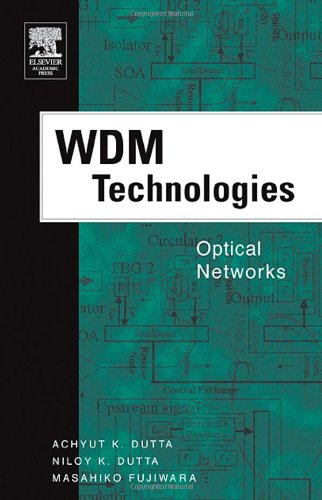Achyut K. Dutta, Niloy K. Dutta, Masahiko Fujiwara0122252632, 9780122252631
Table of contents :
Team DDU……Page 1
Contents……Page 8
Contributors……Page 14
Foreword: The WDM Revolution……Page 16
Acknowledgments……Page 20
1.1. Prospectus……Page 22
1.2. Organization and Features of the WDM Technologies Series……Page 25
1.3.1. Part I: WDM and TDM Perspectives……Page 26
1.3.2. Part II: Critical Technologies……Page 27
1.3.3. Part III: Applications: Local/Computer WDM Networks……Page 29
References……Page 30
Part 1 Overview and WDM/TDM Perspectives……Page 32
2.1. OTDM and WDM for Large-Scale Photonic Networks as the Global Information Infrastructure……Page 34
2.2. Ultrafast Photonic Processing……Page 39
2.3. Wavelength-Band Generation……Page 46
2.3.2. Experiments and Results……Page 47
2.3.3. Summary of Section 2.3……Page 53
2.4.2. Experiments and Discussions……Page 54
2.4.3. Summary of Section 2.4……Page 57
2.5. Wavelength-Band Conversion……Page 59
2.5.1. HNL-DSFWavelength Converter……Page 60
2.5.2. Ultrafast 640-to-10 Gb/s OTDM DEMUX……Page 61
2.5.3. C-to-LWavelength-Band Conversion of a 640 Gb/s OTDM Signal……Page 62
2.5.4. L-to-CWavelength-Band Conversion of a 640 Gb/s OTDM Signal……Page 64
2.6. Polarization-Mode Dispersion and Its Equalization……Page 68
2.6.1. Polarization-Mode Dispersion Equalization……Page 69
2.6.2. Nonlinear Polarization-Mode Dispersion Equalization……Page 72
2.6.3. Summary of Section 2.6……Page 77
References……Page 78
Part 2 Critical Technologies……Page 84
3.1.1. Role of Path……Page 86
3.1.2. Electrical Path Technologies……Page 89
3.2.1. Optical Path……Page 94
3.2.2. Characteristics and Benefits of Optical Path Networks……Page 97
3.2.3. Wavelength Path and VirtualWavelength Path……Page 105
3.2.4. IP Over Optical Path and Photonic MPLS……Page 108
3.3. Optical Path Cross-Connect System……Page 112
3.3.1. System Architecture……Page 114
3.3.2. Optical Switch Component Technologies……Page 122
3.3.3. Interface Technologies……Page 129
3.3.4. Fault Management and Supervision Technologies……Page 133
References……Page 135
4.1.1. General Packet-Switch Architecture……Page 140
4.1.2. Optical Packet-Switch Architecture……Page 143
4.2.1. Space Division Switch……Page 146
4.2.2. Optical Buffer Memory……Page 147
4.2.3. Packet Synchronizer……Page 149
4.2.4. Burst Receiver……Page 151
4.3.1. Optical Switch……Page 152
4.3.2. Optical Implementation……Page 154
4.4. Optical Burst Switch……Page 155
4.5.1. NEC Testbed……Page 156
References……Page 158
5.1. Outline……Page 162
5.2. Progress of Optical Submarine Networks……Page 163
5.3.1. Submerged Plant……Page 167
5.3.2. Station Equipment……Page 172
5.4. Network Configuration……Page 180
5.4.1. Ring Networks……Page 181
5.4.2. Trunk-and-Branch Networks……Page 184
5.4.4. Mesh Networks……Page 185
5.5.1. Transoceanic Ring Network Protection……Page 186
5.5.2. Network Protection Equipment (NPE) and TPC-5 CN……Page 192
5.5.3. Network Operation and Maintenance……Page 194
5.5.4. Optical Network Protection Equipment (ONPE) and JIH Cable……Page 196
5.6.1. Recent Problems in Traditional Submarine Network Configuration……Page 198
5.6.2. Survivability and Topology……Page 202
5.6.3. OXC-Based Mesh Networks and Their Benefits to Submarine Cable Systems……Page 203
References……Page 206
Part 3 Applications……Page 210
6.2. Current Features……Page 212
6.3.2. WDM Schemes……Page 215
6.3.3. Optical Components……Page 219
6.3.4. Features of WDM Technology……Page 225
6.4.1. Wavelength Region for WDM Transmissions……Page 227
6.4.2. Architecture……Page 228
6.4.3. WDM Systems……Page 231
6.4.4. WDM Technology……Page 242
6.5.1. Network Image and Its Requirements……Page 257
6.5.2. Wavelength Utilization……Page 258
6.5.3. Cost-Effective Approach……Page 259
6.6. Standardization……Page 260
6.8. Conclusion……Page 262
References……Page 263
7.1. Introduction……Page 270
7.2. Requirements for a Signal Routing Network in a Contemporary Broadcast Center……Page 271
7.3. Proposed WD/TD Optical Network……Page 273
7.4.1. WDM System……Page 277
7.4.2. TDM System……Page 282
7.5.1. Network Design……Page 284
7.5.2. Practical Network Implementation……Page 286
7.6. Conclusion……Page 292
References……Page 293
8.1. Introduction……Page 296
8.2.1. Effectiveness of WDM……Page 297
8.2.2. Economic Benefits of WDM……Page 300
8.3. Local Optical Networks: WDM LAN……Page 301
8.3.1. Broadcast-and-Select (Local) Optical WDM Networks……Page 302
8.4.1. Metropolitan Technologies……Page 306
8.4.2. WDM in Metropolitan Area Networks……Page 307
8.5.1. Wavelength Routing Networks……Page 311
8.5.2. Fixed and ConfigurableWavelength Routers……Page 312
8.5.3. Wavelength Conversion……Page 314
8.5.4. Routing andWavelength Assignment……Page 316
8.6.1. Passive Optical Networks……Page 317
8.6.2. IP over WDM……Page 319
8.6.4. Military Applications……Page 320
References……Page 322
Index……Page 324







Reviews
There are no reviews yet.